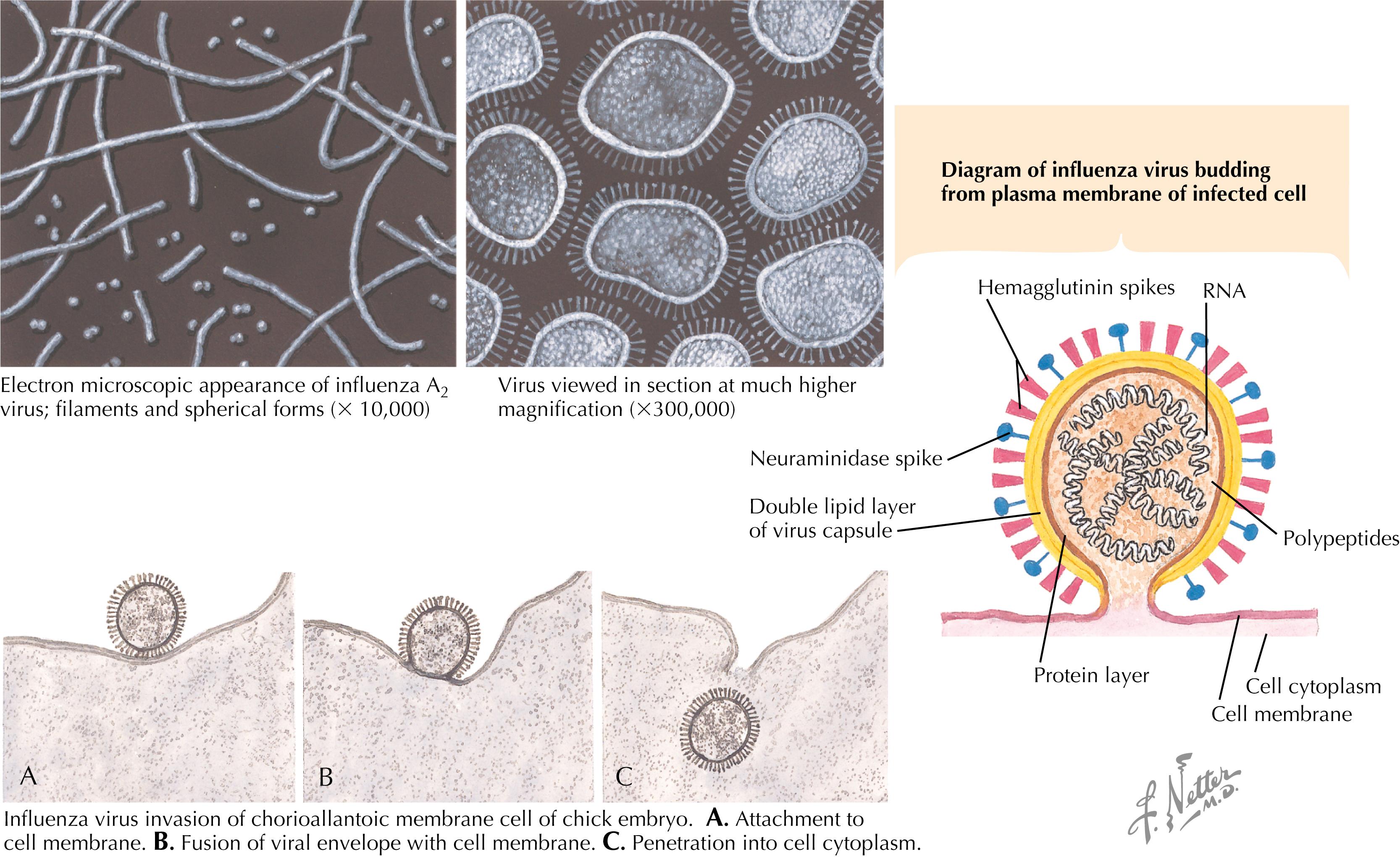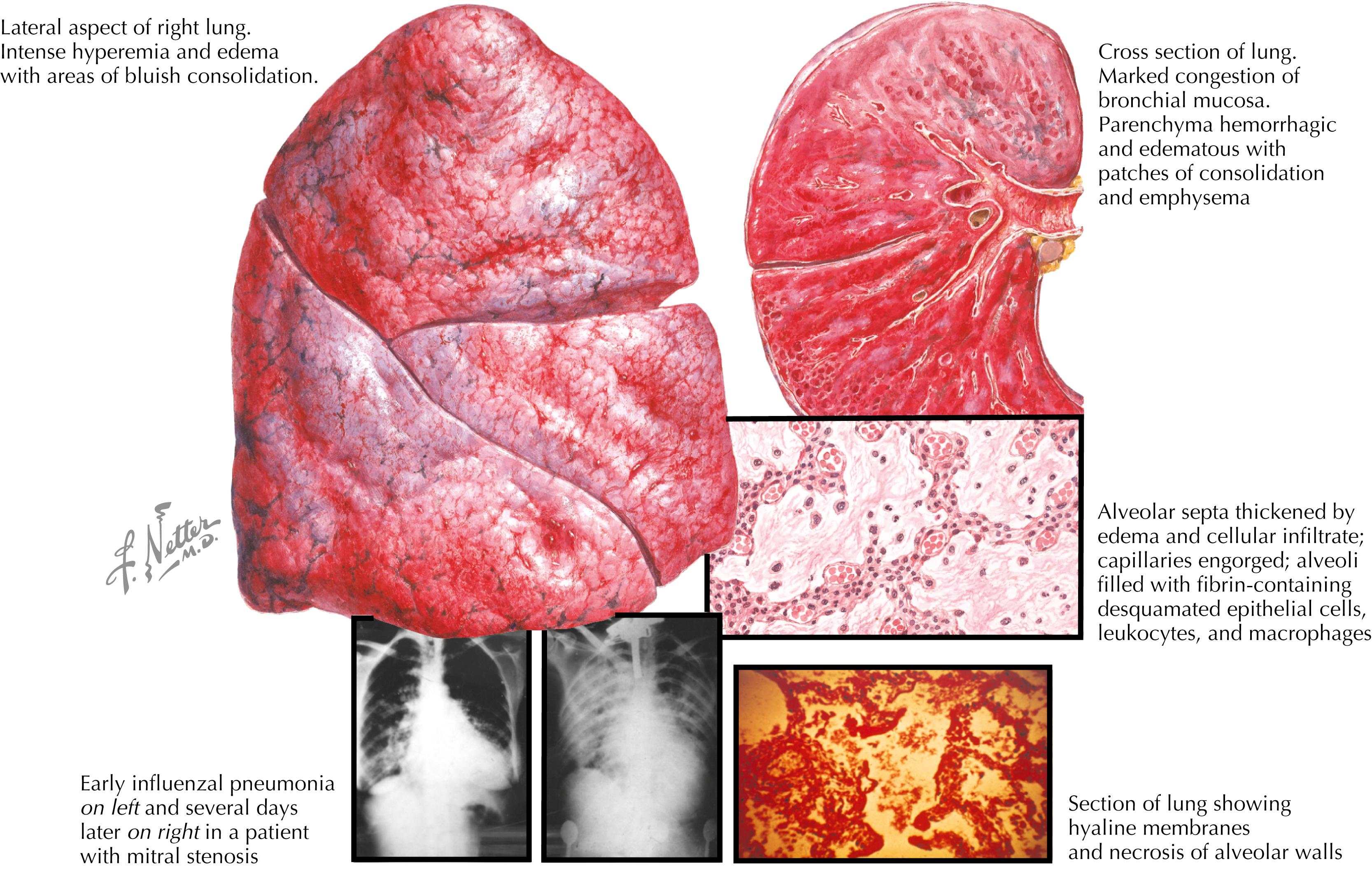Physical Address
304 North Cardinal St.
Dorchester Center, MA 02124
Viruses are an important but underrecognized cause of pneumonias. The exact percentage of all pneumonias caused by viral infection is unknown, but viruses are probably responsible for at least 25% of cases. This figure will likely change as a result of utilization of molecular diagnostic panels. The most common respiratory viruses are influenza, rhinovirus, coronavirus, respiratory syncytial virus (RSV), parainfluenza virus, human metapneumovirus, and adenovirus. Multiplex polymerase chain reaction (PCR) detection enables relatively simple detection. Patients with severe chronic lung disease, chronic medical conditions, immunosuppression, and the elderly are groups most susceptible to viral pneumonia. With the exception of influenza, treatment is largely supportive.
A 68-year-old woman with chronic obstructive pulmonary disease comes to the emergency department in early July with fever, cough, and wheezing for 3 days. She has young grandchildren that she was watching for her family. Her vital signs were stable, and her physical examination was unremarkable other than fatigued appearance and scattered expiratory wheezes. She had no leukocytosis and her procalcitonin was less than 0.1. Chest radiograph demonstrated chronic changes associated with her lung disease. Legionella and pneumococcal urine antigens were not detected. Nasopharyngeal swab sent for respiratory PCR reveals parainfluenza virus. The patient is discharged with supportive care measures, no antimicrobial agents, and she recovers uneventfully.
Influenza viruses are enveloped, single-stranded ribonucleic acid (RNA) viruses of the family Orthomyxoviridae. The viruses are classified as type A, B, or C and subtyped based on differences in the surface hemagglutinin (H) and neuraminidase (N) glycoproteins. Influenza A is the leading cause of influenza in adults in the United States and is responsible for 90% of all epidemic influenza. Prevention, diagnosis, and treatment are important, as secondary bacterial pneumonia can be severe and is not uncommon.
In the United States, influenza virus has no geographic predilection. It is spread by respiratory secretions from individuals who are actively shedding the virus. Incubation is approximately 1 to 5 days. Epidemics occur annually during the winter months. It is associated with 10,000 to 40,000 excess deaths. For seasonal influenza, 80% of these deaths are in patients older than 65. Patients with chronic lung diseases such as chronic obstructive pulmonary disease and emphysema, congestive heart failure, hemoglobinopathies, and immunosuppression are at risk for severe disease ( Fig. 30.1 and Box 30.1 ).

Persons older than 65 years of age
Nursing home residents
Adults and children with chronic cardiopulmonary disease
Immunocompromised adults with diabetes mellitus, renal failure, human immunodeficiency virus, and other immunosuppressive diseases
Patients receiving chronic corticosteroids or other immunosuppressive medications
Pregnant women who will be in the second and third trimester of pregnancy during influenza season
Clinical manifestations include an acute febrile respiratory illness with cough, sore throat, headache, malaise, and myalgias. Symptoms are usually self-limited, with the major symptoms improving after 3 to 5 days. Complications can include secondary bacterial infections caused by Streptococcus pneumoniae, Staphylococcus aureus, Haemophilus influenzae, or gram-negative pathogens. These secondary infections are often suggested by initial improvement followed by clinical worsening ( Fig. 30.2 ). Diagnosis of influenza is suggested by the symptoms listed earlier, usually with the presence of influenza in the community. Confirmation can be made with several available rapid diagnostic tests that detect viral nucleoproteins or viral neuraminidase, although RT-PCR that detects viral RNA is the preferred diagnostic modality. Rapid influenza diagnostic tests have high specificity (>90%) but have low to moderate sensitivity (20% to 70%) compared with other influenza tests and PCR detection. These and other virus and viral antigen detection methods may also be helpful in nonepidemic months ( Table 30.1 ).

| Respiratory syncytial virus infection | Tracheal aspirate or bronchial alveolar lavage for viral culture, antigen testing by ELISA and fluorescein conjugate monoclonal or polyclonal antibody, RT-PCR |
| Parainfluenza | Nasal and bronchial secretions for viral culture and immunofluorescent assays, RT-PCR Serum for complement fixation and hemagglutination |
| Influenza | Respiratory secretions for viral cultures and immunofluorescent and ELISA assays, RT-PCR |
| Adenovirus infection | Respiratory secretions for viral culture, complement fixation, hemagglutination inhibition, and neutralization, PCR |
| Rhinovirus/Enterovirus | Respiratory secretions for viral culture, PCR |
| Coronavirus | Respiratory secretions for viral culture, PCR |
Treatment is largely supportive with management of symptoms with antipyretics and analgesics. The neuraminidase inhibitors oseltamivir (oral) and zanamivir (inhaled) are traditionally effective against influenza A and B. Peramivir offers an intravenous option, and baloxavir, a cap-dependent endonuclease inhibitor (CEN), offers a single oral dose. The tricyclic amines, amantadine and rimantadine, are classically active against only influenza A. Widespread resistance of influenza A (H3N2) and 2009 pandemic H1N1 to amantadine and rimantadine has been seen. Presently, therefore, only neuraminidase inhibitors or baloxavir should be used if influenza is suspected. The recent Infectious Diseases Society of America (IDSA) guideline emphasizes that during times of influenza activity, a clinical diagnosis is adequate for the decision to initiate antiviral therapy without the need for testing. The guideline also suggests immediate initiation of antiviral treatment for adults and children with documented or suspected influenza, regardless of vaccination history if they are (1) hospitalized with influenza regardless of duration prior to hospitalization, (2) outpatients with severe or progressive illness, regardless of duration of illness, (3) outpatients at high risk of complications from influenza, including those with chronic medical conditions or immunocompromising states, (4) patients younger than 2 years or 65 years or older, and (5) pregnant patients and those within 2 weeks postpartum. Treatment consideration can be given to those outpatients with uncomplicated disease with onset 2 days or less before presentation, and symptomatic outpatients who are household contacts of those who are at high risk for influenza complications. Resistance to neuraminidase inhibitors of predominant strains is rare (<1%). The neuraminidase inhibitors are also effective for chemoprophylaxis. The current antiviral recommendations are readily available from the Centers for Disease Control and Prevention website on seasonal influenza, www.cdc.gov/flu .
The most effective means of prevention is with annual influenza vaccination. All persons older than 6 months of age are recommended to have annual seasonal influenza vaccination. Several vaccine formulations are available with the considerations being quadrivalent versus trivalent (most are quadrivalent now), intranasal live attenuated versus intramuscular recombinant or inactivated, high dose versus standard dose. These vaccines contain the three or four virus strains that are projected to be responsible for the annual epidemic. Vaccination is usually effective from about 2 weeks to 4 to 6 months postvaccination. However, data suggest vaccination efficacy is maintained late in the season and into the summer; vaccination should be given at earliest availability and should not be delayed until later in the season. Current influenza vaccine details are available at www.cdc.gov/flu .
Become a Clinical Tree membership for Full access and enjoy Unlimited articles
If you are a member. Log in here